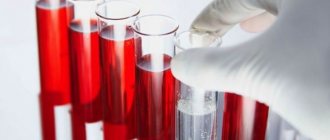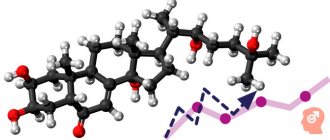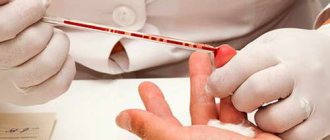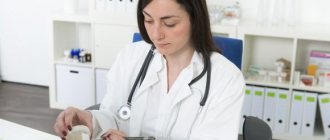CRP – indications for examination
CRP is assigned:
- if the patient is at risk of a bacterial infection;
- For patients recovering from surgery, if CRP values remain elevated three days after surgery, a bacterial infection may be suspected;
- newborns with signs of infection;
- patients with signs of sepsis: fever, chills, rapid breathing and palpitations;
- when a health condition needs to be assessed, such as lupus or arthritis;
- to check the effectiveness of inflammation therapy - during it, the level of CRP should decrease;
- to study body damage and consequences after operations, organ transplants and burns, for early detection of possible infection.
The CRP test can help with:
- assessing the severity of the inflammatory process;
- early detection of postoperative complications;
- detection of transplant rejection;
- monitoring the success of antibiotic treatment for bacterial infections;
- monitoring patients with inflammatory rheumatic diseases.
Thus, the most common use of the CRP test is to determine its level when inflammation caused by a bacterial infection is suspected.
This is especially useful for distinguishing viral from bacterial infections. Since in viral infections - inflammations accompanied by increased sedimentation and an increase in the number of leukocytes, the level of CRP remains in a lower range than in the case of a bacterial infection. And in this case his growth is much higher.
An increase in CRP is present in the following cases:
- with inflammation;
- after operation;
- in the presence of malignant diseases;
- for allergic reactions;
- for chronic inflammatory diseases such as rheumatoid arthritis or lupus.
Treatment of rheumatoid arthritis in women in our clinic
Treatment of rheumatoid arthritis in women in the clinic
At the Moscow clinic “Paramita” they approach the treatment of female forms of rheumatoid arthritis with special care. To do this, a comprehensive examination of the patient is carried out, identifying hormonal disorders and concomitant diseases that contribute to the development and maintenance of the autoimmune inflammatory process. Correction of these disorders is necessarily part of the complex therapy of a woman suffering from rheumatoid arthritis.
We combine proven techniques of the East and innovative methods of Western medicine.
Read more about our unique method of treating arthritis
The doctors of our clinic have at their disposal a wide range of the latest European and traditional oriental healing methods. In our practice we use:
- drug therapy, combining the administration of the most effective modern drugs, medicinal herbs and homeopathic remedies; this allows you to quickly relieve pain and significantly reduce the drug load on the patient’s body;
- physiotherapeutic procedures - their skillful combination with drug therapy according to modern regimens leads to a rapid improvement in a woman’s condition;
- kinesitherapy, taping, exercise therapy and massage courses are selected strictly individually, preventing the development of ankylosis and joint deformities;
- PRP therapy is a unique modern method of stimulating the regenerative abilities of tissues by introducing the patient’s own platelets, processed using a special technique;
- reflexology (RT) - influence on acupuncture points (AP) on the human body, reflexively connected with various organs and systems; our specialists have been trained in RT in China and Tibet, they are proficient in all methods of RT - acupuncture, cauterization with wormwood cigarettes, acupressure, etc.; in skillful hands, the effectiveness of RT can be equal to the effectiveness of drug therapy;
- pharmacopuncture – introduction of modern medicines into AT; one of the most effective ways to treat RA.
This approach to the treatment of rheumatoid arthritis in women allows patients to constantly be in a state of remission. They regularly undergo courses of maintenance therapy in our clinic, lead an active lifestyle, forgetting about painful exacerbations and the prospect of disability.
High CRP and disease diagnosis
During an acute inflammatory reaction, the concentration of CRP increases many times over. It begins to grow 6 to 9 hours after the onset of inflammation and reaches a maximum after 48 hours. Protein returns to baseline levels within 7 to 10 days after stopping treatment.
| SPB level | Meaning | What does it indicate? |
| <5 mg/l | Normal | No inflammation |
| 0-40 mg/l | Slightly elevated | Mild inflammation |
| 40-200 mg/l | Increased | Acute inflammation |
| 200 and above mg/l | High | Severe bacterial infection |
Testing the concentration of C-reactive protein often reveals problems in the proper functioning of the body at an early stage before symptoms appear.
| Type of infection | SPB level |
| Gram-negative bacteria – Escherichia coli, Salmonella, Helicobacter pylori and others | 500 mg/l or more |
| Gram-positive bacteria – staphylococci, streptococci, tuberculosis or parasites | up to 100 mg/l |
| Viruses | up to 50 mg/l |
Results above 50 mg/L are a sign of serious infection, injury, or chronic disease, which will require additional testing to determine the cause.
In such situations, rapid identification of the bacterial pathogen is especially important to determine targeted antibiotic therapy.
Elevated C-reactive protein in coronavirus
Research on CRP levels has taken on added significance during the COVID-19 pandemic. The marker is considered as the main indicator of the activity of the inflammatory process in the lungs. Determination of CRP in patients with COVID-19 allows us to evaluate the following indicators:
- The severity of the disease. If a CRP level of 10 mg/l or more is determined, this indicates a moderate course of the disease. In severe cases, CRP can increase to 100 mg/l or more. At the same time, the level of CRP correlates with the volume of damage to the lung tissue.
- Monitoring of moderate and severe patients. The CRP level is determined within 24 hours after the patient is admitted to the hospital. Then, in moderately severe patients, the analysis is carried out 2 times a week, and in severe patients - every 48 hours.
- Monitoring the patient's condition with ARDS. In acute respiratory distress syndrome (ARDS), CRP levels are determined every 2-3 days. An improvement in condition is judged by a persistent decrease in the indicator.
- Development of macrophage activation syndrome (MAS). This is a serious condition that threatens the patient's life. An increasing level of CRP (in combination with some other markers) may indicate the development of MAS.
The indication for discharge from hospital is a CRP level of less than 10 mg/l.
In every second patient with coronavirus, C-reactive protein increases in the first days of the disease. Photo: halfpoint/Depositphotos
What can a CRP test show?
C-reactive protein manifests itself as a protective reaction of the body. Its function is to participate in the immune response, which consists in inactivating the inflammatory factor and stimulating the function of immune cells.
Quantitative CRP testing has less diagnostic value in the case of chronic inflammatory diseases such as rheumatic diseases, since the CRP value can vary from 10 to 1000 mg/L. However, diagnostically important is the fact that the level of CRP is associated with the degree and activity of the inflammatory process. Monitoring changes in the concentration of C-reactive protein - decrease or increase - informs about the stage of inflammation, its extinction or failure of therapy.
Before taking a CRP test, it is recommended that you consult with your doctor in advance to discuss any medical conditions that may affect the results.
It is important that your consultation with your doctor takes into account lifestyle risk factors, other medical conditions and family history. If there is a risk of cardiovascular disease, an echocardiogram, computed tomography of the coronary arteries, a stress test, cardiac catheterization or an electrocardiogram may be prescribed.
What it is
CRP is a blood plasma protein whose concentration increases during inflammation.
The bulk of the protein is produced in liver cells in response to certain signals from macrophages (immune cells)¹. The main function of SRB is protective. It activates the complement system (a group of proteins with antibacterial activity), as well as some cells of the immune system. The concentration of CRP increases in proportion to the scale of the inflammatory process. The more inflammation, the more protein is produced in the liver.
When inflammation becomes chronic, the level of CRP decreases (sometimes to zero). However, during exacerbations it rises again.
Another property of CRP is the binding of low-density lipoproteins (LDL)². This is the so-called “bad cholesterol”. Thus, this protein also contributes to the development of atherosclerosis. An increase in C-reactive protein concentrations in the absence of acute infection or injury may indicate a risk of cardiac pathologies.
CRP and cardiovascular disease
Recently, CRP protein levels have also been taken into account in the diagnosis and treatment of cardiovascular diseases. It is used to assess the risk of myocardial infarction, ischemic stroke and sudden cardiac arrest. It turns out that there is a relationship between the risk of coronary heart disease and the level of CRP in the patient’s blood.
Low levels of CRP accompany mild inflammation, which medicine associates with atherosclerosis because the inflammatory process plays a key role in the detachment of atherosclerotic plaques, the formation of local blood clots and blockage of blood vessels. CRP levels are also associated with hypertension, low good cholesterol, and metabolic disorders leading to abdominal obesity.
According to the Cleveland Clinic, a non-profit multidisciplinary academic medical center (Ohio, USA), the CRP test can be used to identify the risk of developing cardiovascular diseases:
| CRP value | Risk of developing cardiovascular diseases |
| below 1 mg/l | Short |
| from 1 to 2.9 mg/l | Moderate |
| exceeds 3 mg/l | High |
However, the CRP test does not provide a complete picture of the risk of cardiovascular disease.
Other causes of elevated CRP
If the reading is above 10 mg/L, this may be a signal for further research to answer the question of what is causing the inflammation.
Such a high CRP value may indicate:
- osteomyelitis or bone infection;
- tuberculosis;
- inflammatory bowel diseases;
- lupus;
- connective tissue disease;
- some kind of autoimmune disease;
- exacerbation of autoimmune arthritis;
- pneumonia;
- type 2 diabetes;
- cancer – with a special indication for lymphoma.
Increased levels of CRP may occur in women:
- taking birth control pills;
- in pregnant women - this condition may indicate complications, so additional tests should be carried out to be sure.
CRP and cancer
The highest concentrations of CRP are observed in patients with malignant neoplasms, especially neoplasms of the hematopoietic system. Sometimes these are three-digit numbers or more. If the CRP blood test results show a high level of C-reactive protein, doctors immediately begin looking for a neoplastic process that, in addition to the elevated CRP level, has not yet caused any symptoms other than an altered ESR level.
However, keep in mind that the CRP test is not useful in diagnosing cancer. Too many other factors influence its level. A low level of CRP does not exclude the presence of a neoplasm, and its elevated level should direct the diagnosis primarily to infectious and inflammatory diseases. Moreover, the CRP protein is a very plastic molecule: the rate can increase up to a thousand times in 24 or 48 hours - this happens during acute bacterial or viral infections and after serious injuries.
Blood test for C-reactive protein
Blood to determine the level of C-reactive protein is taken from a vein.
Photo: freepik.com As a rule, C-reactive protein is determined in a biochemical blood test (CRP). The indicator is measured in milligrams per liter (mg/l). Blood for this analysis is taken from a vein.
Normal CRP values may vary between laboratories. In most cases this is up to 1 mg/l. In some institutions - up to 5 mg/l. There is no lower limit for this marker, since the protein is determined in the acute phase of inflammation.
CRP or ESR?
Many of us are familiar with such an analysis as ESR - erythrocyte sedimentation rate. This is another marker of inflammation, but not as accurate and specific as CRP. The C-reactive protein test has several advantages over ESR, namely:
- CRP increases within a few hours after the onset of inflammation. It decreases faster with anti-inflammatory therapy. If pathological ESR levels last up to 2-4 weeks after inflammation is eliminated, then CRP lasts up to 10 days.
- CRP indicators do not depend on gender (the same for men and women), the number of red blood cells per unit volume of blood and time of day. And these factors influence ESR.
Elevated CRP – is this always a pathology?
In adults, an elevated CRP value exceeds 5 mg/l, with the exception of smokers, people with obesity or hypertension, for whom the norm is less than 10 mg/l.
In older children, elevated CRP values are considered to be greater than 10 mg/L. As with adults, interpretation of the result should be left to the pediatrician. He will evaluate the result in the context of the child's condition and medical history.
Slightly elevated CRP values up to 40 mg/l may be observed in older people and during pregnancy.
Therefore, when interpreting the results and drawing up a medical report, it is necessary to take into account other laboratory parameters, such as a complete blood count (CBC) with a leukocyte formula.
What do deviations from the norm mean?
A doctor should interpret the results. Since there is no protein in the blood of a healthy child or its concentration is minimal, there is no need to talk about a reduced level. Exceeding the normal level of CRP in the blood of children as a result of the analysis may indicate:
- up to 30 mg/l – viral diseases, systemic rheumatic pathologies, malignant diseases;
- up to 100 mg/l – acute bacterial infections, exacerbation of chronic and rheumatic pathologies, tissue damage, including after operations;
- up to 300 mg/l – extensive burns, sepsis.
Deviations from the norm are not a diagnosis and require additional examination. Depending on the clinical picture and complaints of the child, treatment can be carried out by otolaryngologists, urologists, dentists, surgeons and other specialized doctors. To establish a diagnosis and develop a treatment plan, doctors prescribe additional instrumental and laboratory tests.
Effect of drugs on CRP concentration
Taking acetylsalicylic acid or aspirin, even in high doses, does not affect the quantitative level of CRP. This is somewhat surprising since aspirin is known for its anti-inflammatory properties.
Patients with high cholesterol who take statins are less likely to have a heart attack because statins not only lower lipid levels but also have anti-inflammatory properties. This is very important because high CRP and low cholesterol are more dangerous than high cholesterol and low CRP. The level of CRP is also reduced by drugs from the group of fibrates and beta-blockers, but less effectively than by statins.
C-reactive protein and ESR
ESR or Birnatsky reaction is a measurement of the erythrocyte sedimentation rate in a test tube with blood. It is expressed in millimeters per hour. ESR is an indirect indicator of the inflammatory response. However, the ESR test is less specific than CRP.
In addition to inflammation, an increase in ESR is also affected by:
- Obesity. Adipose tissue is a source of interleukin 6. This is one of the proteins involved in the formation of inflammation.
- Kidney failure. In end-stage renal failure and in the case of nephrotic syndrome, patients have significantly increased ESR values.
- Hemoglobin concentration. Anemia speeds up the decline of red blood cells.
- Shape of red blood cells. Determination of ESR is unreliable in diseases with abnormal red blood cells, such as sickle cell disease.
If there is a disproportion between CRP concentration and ESR, the first step is to consider the possibility of a false measurement due to the above factors or laboratory error, such as taking too long from collection to delivery to the laboratory or storing the tube in inappropriate conditions.
CRP levels respond more dynamically to increased inflammation than ESR. In the case of, for example, lupus erythematosus, the ESR value may be elevated when the level of CRP in the blood is low. This is caused by high levels of type 1 interferon, which suppresses the liver's production of CRP.
If you find an error, please select a piece of text and press Ctrl+Enter







